Ijraset Journal For Research in Applied Science and Engineering Technology
- Home / Ijraset
- On This Page
- Abstract
- Introduction
- Conclusion
- References
- Copyright
Interpreting Cardiovascular Disease using Random Forest and Explainable AI
Authors: Aishwarya Dabir, Pratiksha Khedkar, Laxmi Panch, Tejal Thakare, Dr. M. A. Pradhan
DOI Link: https://doi.org/10.22214/ijraset.2023.52922
Certificate: View Certificate
Abstract
These days, artificial intelligence and machine learning in trendy have proven terrific performances in lots of obligations, from image processing to natural language processing, specifically with the advent of machine learning in conjunction with studies development, they\'ve encroached upon many specific fields and disciplines. a number of them require excessive degree of duty and as a result transparency, as an instance the clinical region studies into Explainable Artificial Intelligence (XAI) has been increasing in current years as a response to the need for extended transparency and believe in AI. that is especially crucial as AI is utilized in sensitive domain names with societal, moral, and safety implications reasons for system choices and predictions are as a consequence had to justify their reliability. This requires extra interpretability, which frequently approach we need to understand the mechanism underlying the algorithms. by means of applying the same categorization to interpretability in clinical research, it is hoped that (1) clinicians and practitioners can in the end method those strategies with caution, (2) insights into interpretability could be born with greater issues for scientific practices, and (3) initiatives to push ahead statistics-based totally, mathematically- and technically-grounded scientific schooling is recommended.
Introduction
I. INTRODUCTION
Artificial Intelligence (AI) has become more and more popular within the healthcare industry for sickness diagnosis, analysis, and remedy. however, the "black box" nature of a few AI algorithms has raised concerns regarding the interpretability and transparency of the results produced[1]. This loss of interpretability is specifically tricky within the case of complicated sicknesses together with cardiovascular ailment (CVD), that's the leading cause of loss of life globally. To address this problem, Explainable AI (XAI) has emerged as a new paradigm in AI studies that specializes in growing fashions that could offer a clean and comprehensible clarification in their decision-making manner.
Explainable AI (XAI) refers to the development of artificial intelligence systems that may provide clean and understandable causes for their decision-making processes.
The purpose of XAI is to make AI systems greater transparent and responsible, so that human beings can consider them and make informed decisions primarily based on their output. XAI objectives to enhance the transparency and interpretability of AI algorithms, making them more accessible and useful for clinicians and patients. XAI is an active area of research, and there are numerous exclusive procedures to developing explainable AI structures.
A few strategies include building AI structures that use simpler models or are trained on smaller, more comprehensible datasets, or creating visualization equipment that permit people to look the internal workings of an AI system. other strategies contain developing algorithms that can generate natural language motives for his or her output or that could spotlight the most relevant capabilities in the facts that contributed to a selected selection.
In general, XAI is a vital area inside the development of accountable and ethical AI systems, and it is likely to play an increasingly more vital position as AI becomes more incorporated into our everyday lives.
The Explainable AI (XAI) program goals to create a collection of system gaining knowledge of techniques that:
- Produce more explainable models, while maintaining a high stage of gaining knowledge of performance (prediction accuracy)
- Enable human users to understand, appropriately trust, and efficaciously manage the emerging generation of artificially intelligent partners.
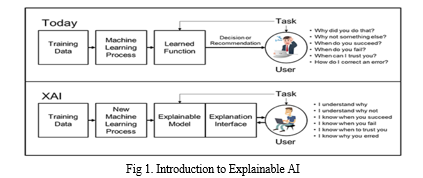
Explainable AI (XAI) is an emerging field that goals to make artificial intelligence (AI) more transparent and understandable to human beings. within the context of cardiovascular disease evaluation[1], XAI can assist clinicians and researchers understand how AI models arrive at their predictions, that can result in better decision-making and patient outcomes. a number of the goals of XAI for cardiovascular disease analysis encompass:
a. Transparency: XAI can assist uncover the black box of AI models, permitting clinicians and researchers to peer the reasoning behind the model's predictions.
b. Interpretability: XAI can help give an explanation for how AI model arrive at their predictions, permitting clinicians and researchers to understand the factors that contribute to the model's output.
c. Trust: by way of making AI greater transparent and interpretable, XAI can assist build consider among clinicians and AI models, that is crucial for the adoption of AI in healthcare.
d. Scientific selection-making: XAI can help clinicians make greater knowledgeable decisions by means of supplying them with the reason behind the AI model’s predictions.
e. Patient Outcomes: By means of allowing better decision-making, XAI can in the long run result in advanced patient consequences within the prognosis, remedy, and control of cardiovascular ailment.
A. Dataset
For our system we have used heart disease dataset, which is collected from UCI repository. All information about the dataset is given in following table.
|
Dataset |
Instance |
Attributes |
|
Heart Disease Dataset |
918 |
12 |
Table1.Total Instances

II. FEATURE-BASED TECHNIQUES
This segment gives function-based totally model explainability strategies, which de-notice how much the input features make a contribution to model’s output. there are numerous function-primarily based methods available consisting of Local Inter-pretable Model-agnostic Explanations (LIME) and Shapley Additive Explana-tions (SHAP).
A. LIME
LIME (Local Interpretable Model-agnostic Explanations) is an explainable AI technique used to interpret the predictions made by a machine learning model at the local level. It provides an explanation of how a particular prediction is made by the model by highlighting the important features that contributed to the prediction. Here we are using random forest as our model to generate explanations
LIME creates a surrogate model that is trained on a small subset of the original data, in the vicinity of the prediction to be explained. The surrogate model is usually a linear model or a decision tree that is easier to interpret. The important features are identified by perturbing the input features and observing the impact on the prediction. The features that have the greatest impact on the prediction are considered the most important.
LIME can be applied to a wide range of machine learning models, including complex models such as neural networks. It is model-agnostic, which means it can be used with any machine learning algorithm, including black box models.
The output of LIME is a set of local feature importance scores that indicate the importance of each input feature in the prediction for a particular instance. These scores can be visualized using various techniques such as bar charts or heat maps, to help users understand how the model makes predictions[2].
LIME is useful for explaining individual predictions and gaining insights into how a machine learning model works. It can help increase the transparency and trust in the model by providing interpretable explanations for its predictions.
Mathematical formula

Steps of LIME for cardiovascular ailment evaluation:
- Train a black-box machine learning model: A machine getting to know model is trained on a huge dataset of patient heath records to predict the risk of cardiovascular ailment.
- Select a patient for explanation: A affected person record is selected for which the machine learning model has made a prediction of cardiovascular disease.
- Generate local data points: LIME generates a hard and fast of perturbed data points round the selected patient record to create a neighborhood community. This community represents the range of statistics points which can be similar to the selected file and on which the local explanation might be based totally.
- Train a local interpretable model: A local interpretable model is trained on the nearby of perturbed data points. This model is designed to be more obvious and interpretable than the original black-box model and can be used to offer an explanation for the prediction made on the selected affected person report.
- Generate feature importance weights: LIME generates characteristic importance weights that suggest how a good deal each function contributes to the prediction made on the chosen patient record. these weights are primarily based on the coefficients of the neighborhood interpretable model and are used to perceive the most important risk features riding the prediction.
- Present the explanation: The features importance weights are supplied to the clinician or patient in a human-readable layout, such as a listing of the most important features or a visualization that indicates how different functions contribute to the general prediction.
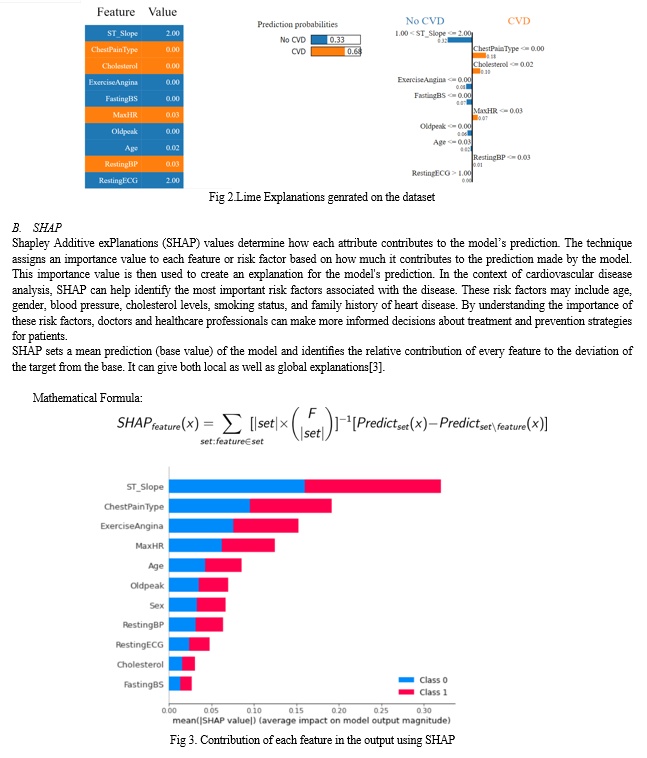
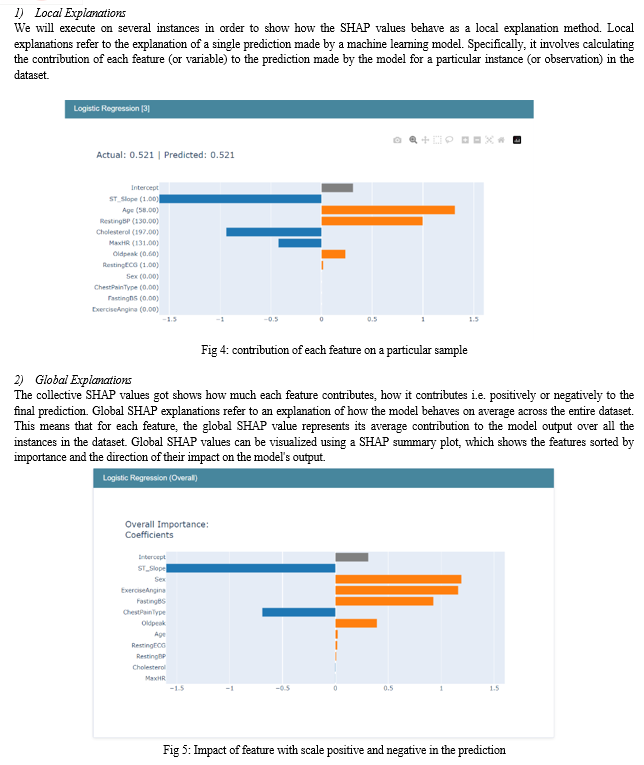
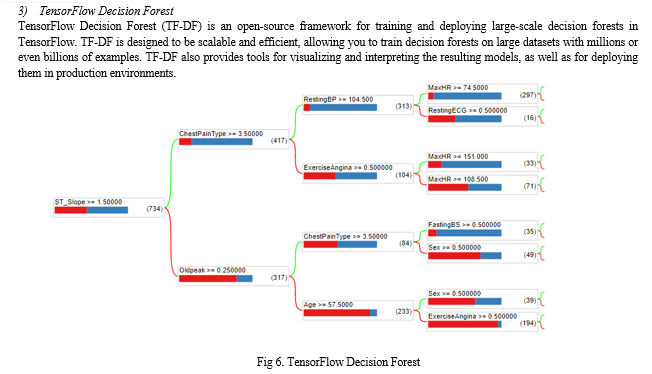
???????C. What-if Tool
The What-If Tool (WIT) provides an easy-to-use interface for expanding understanding of a black-box classification or regression ML model. What-If Tool is an interactive and user-friendly visual interface used for exploring and understanding machine learning models. It allows users to perform "what-if" analysis on a trained model by modifying input features and observing the effect on the model's predictions in real-time.
The What-If Tool provides several features that help users to understand how the model works and how to improve its performance. Some of the key features of the What-If Tool include:
- Data exploration: Users can visualize and explore the dataset used to train the model, and filter data based on different criteria.
- Model analysis: Users can examine the model's performance on different subsets of the data, and evaluate its accuracy and bias.
- Input modification: Users can modify the input features to the model and observe the effect on the prediction. This allows users to test different scenarios and understand how the model responds.
- Counterfactual analysis: Users can generate counterfactual examples by modifying input features to achieve a desired outcome. This can help users understand how to improve the model's performance and make it more fair and transparent.
The What-If Tool is an open-source software developed by Google, and can be used with a wide range of machine learning models and input data types. It can be used in various applications such as healthcare, finance, and marketing, to provide insights and recommendations for decision-making.
In proposed system What-if analysis is done using TensorFlow decision-forest algorithm.
5. ROC Curve
A Receiver Operating Characteristic (ROC) curve is a graphical representation of the performance of a binary classifier. The ROC curve plots the true positive rate (sensitivity) against the false positive rate (1 - specificity) for different threshold values of the classifier.
The true positive rate (TPR) is the proportion of actual positive samples that are correctly classified as positive by the classifier. The false positive rate (FPR) is the proportion of actual negative samples that are incorrectly classified as positive by the classifier.
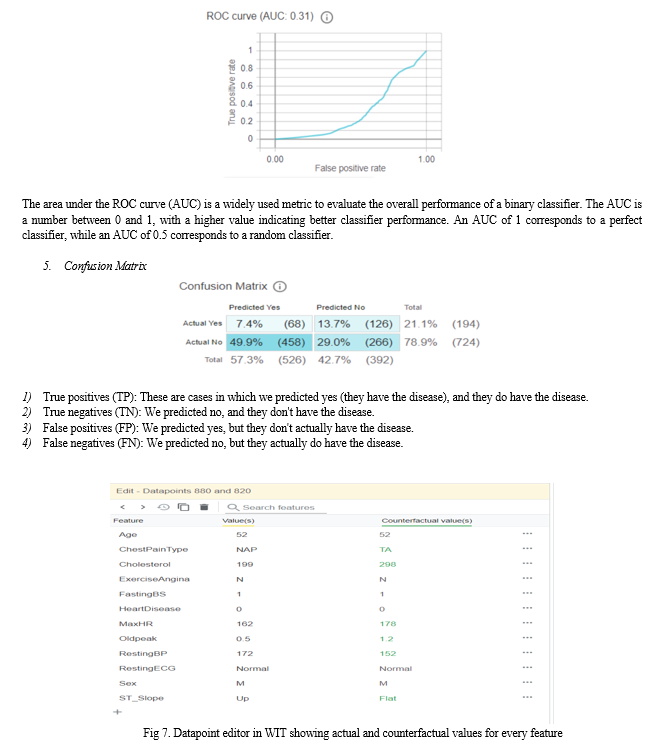
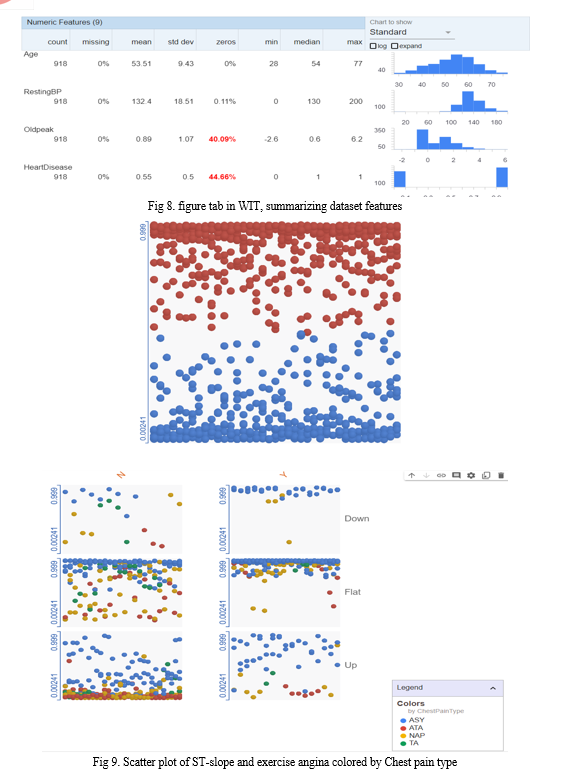
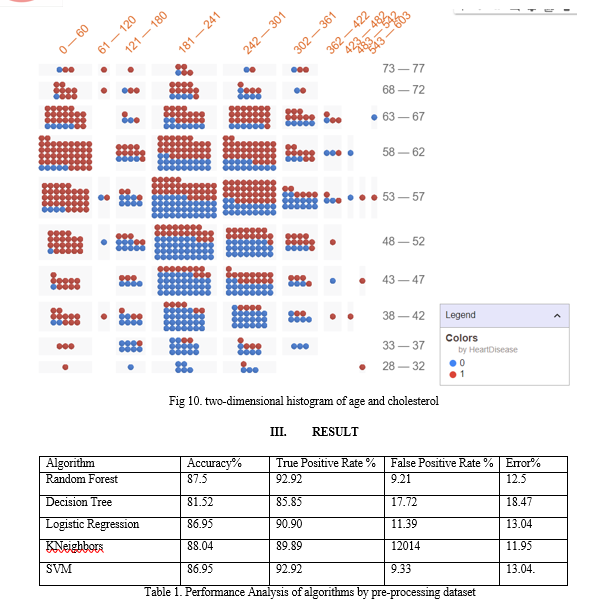
By analysis of the above algorithms performed on the dataset, we observed that the accuracy is majorly increased due to Random Forest after preprocessing data using normalization, label encoding and k-fold validation.
Random Forest is an ensemble learning method that creates multiple decision trees and aggregates their predictions to make a final prediction. The feature importance score is calculated based on the reduction in impurity that is achieved when a feature is used to split the data. The feature importance score can be used to identify the most important features in a dataset and to understand which features have the greatest impact on the model's predictions.
In scikit-learn, the feature importance score is normalized to add up to 1, and can be accessed through the feature_importances_ attribute of the trained RandomForestRegressor or RandomForestClassifier object. This attribute returns an array of importance scores, with the index of each score corresponding to the index of the input feature.
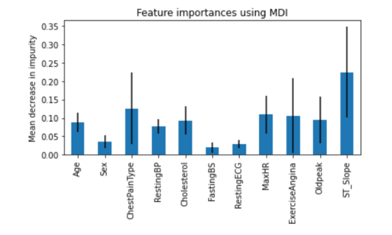 ???????
???????
Conclusion
An application of this concept is in healthcare sector to provide addition information about a disease on the basis of previous data. The explanations generated can correct or incorrect in both cases useful insights are gained. If explanations are correct the trust in model increase hence, encouraging use of XAI and its methodologies in healthcare. If the explanations are incorrect it implies our model is not trained enough. This gives scope for improvement and development of better models and experimentation. The clinical can get better insights about a health condition by looking at the data.
References
[1] Urja Pawar, Donna O’Shea, Susan Rea, Ruairi O’Reilly “Explainable AI in Healthcare”. [2] Marco Tulio Riberio, Sameer Singh, Carlos “Why Should I Trust You?” Explaining the Predictions of Any Classifier. [3] Scott M. Lundberg, Su-In Lee “A Unified Approach to Interpreting Model Predictions”. [4] Sandra Wachter, Brent Mittelstadt & Chris Russell “CounterFractual Explanations Without opening the black box: Automated Decision and the GDPR. [5] Deepti Saraswat, Pronaya Bhattacharya, Ashwin Verma, Vivek Kumar Prasad, Sudeep Tanwar, Gulshan Sharma, Pitshou N. Bokoro & Ravi Sharma “\"Explainable AI for healthcare 5.0: opportunities and challenge”. [6] Wagle, V., Kaur, K., Kamat, P., Patil, S., & Kotecha, K. (2021). Explainable ai for multimodal credibility analysis: Case study of online beauty health (mis)-information. IEEE Access, 9, 127985-128022. [7] J. Wexler, et al.,\"The What-If Tool: Interactive Probing of Machine Learning Models\".
Copyright
Copyright © 2023 Aishwarya Dabir, Pratiksha Khedkar, Laxmi Panch, Tejal Thakare, Dr. M. A. Pradhan. This is an open access article distributed under the Creative Commons Attribution License, which permits unrestricted use, distribution, and reproduction in any medium, provided the original work is properly cited.

Download Paper
Paper Id : IJRASET52922
Publish Date : 2023-05-24
ISSN : 2321-9653
Publisher Name : IJRASET
DOI Link : Click Here
 Submit Paper Online
Submit Paper Online

